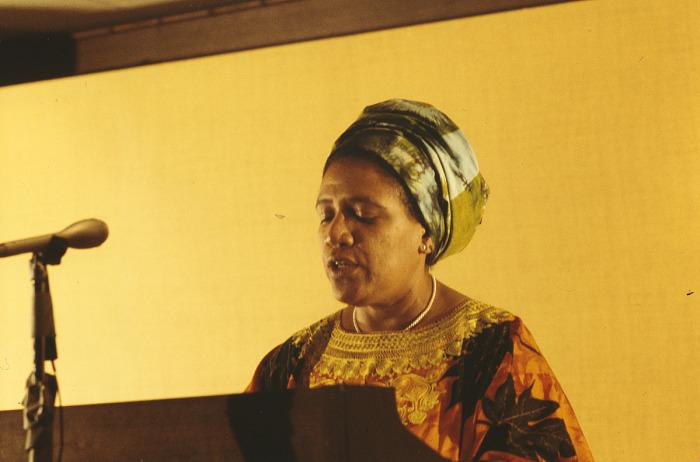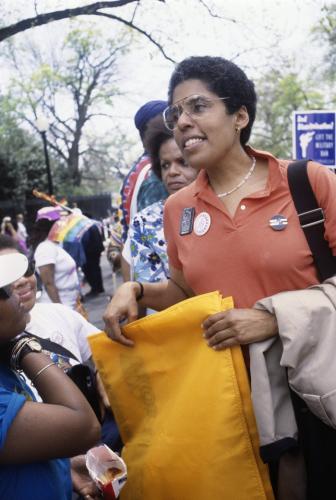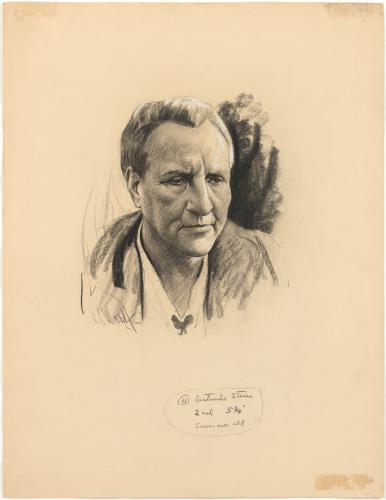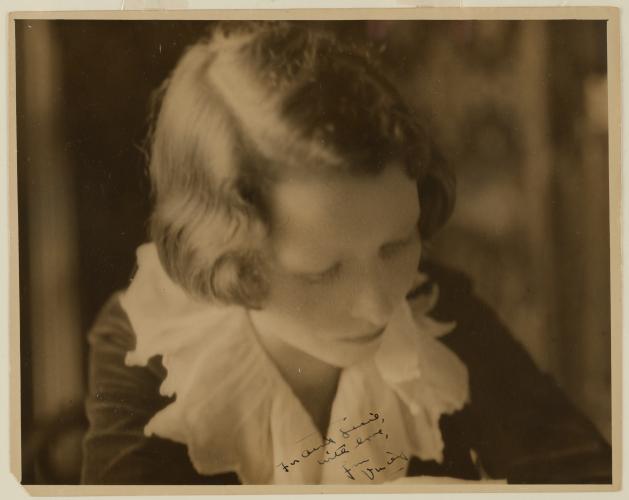
Audre Lorde speaking at the Third World Gay Conference in 1979. Image courtesy of the collection of the Smithsonian National Museum of African American History and Culture, Gift of Ron Simmons, © Ron Simmons
Collaboration and co-creation are at the heart of our mission. In this spirit, we support women’s history across Smithsonian museums, archives, and research centers through our American Women’s History Initiative pool fund. These funds support projects across the Smithsonian that explore, present, celebrate, and preserve the diverse stories of women and girls in America. This month, we’re featuring the legacies of four LGBTQ+ women from two projects that received pool funding: Collected, a podcast produced by the National Museum of American History, and Brilliant Exiles: American Women in Paris, 1900-1939, an exhibition at the National Portrait Gallery.
Barbara Smith

Barbara Smith at a National Gay Rights March in 1993. Image courtesy of the collection of the Smithsonian National Museum of African American History and Culture, Gift of Ron Simmons, © Ron Simmons
Barbra Smith is an educator, author, and activist who founded the Combahee River Collective, a Black feminist lesbian organization whose constituents believed the current equal rights movements in the 1970s failed to capture the overlapping oppressions they experienced. The group authored the “Combahee River Collective Statement” that coined the term “identity politics” and brought intersectional feminism into the mainstream conversation. In addition to her political activism, Smith also taught literature at Emerson College. Frustrated by the lack of availability of published works by women of color, Smith co-founded Kitchen Table: Women of Color Press. The press published influential works by feminist lesbian writers such as Audre Lorde, Gloria Anzaldua, June Jordan, and Cherrie Moraga.
Audre Lorde

Audre Lorde speaking at the Third World Gay Conference in 1979. Image courtesy of the collection of the Smithsonian National Museum of African American History and Culture, Gift of Ron Simmons, © Ron Simmons
Audre Lorde was a writer, professor, philosopher, and civil rights activist. She was a prolific writer of both prose and poetry and used her creative talent to confront the injustices of racism, classism, sexism, and homophobia. Her poetry followed in the spoken word tradition, and she was known for her technical skills and passionate emotional expression. Through her academic positions, she made lasting contributions to the scholarly disciplines of feminist theory, critical race studies, and queer theory. Her 1988 book A Burst of Light coined the term “self-care” as a radical act of political resistance. She wrote the book after being diagnosed with cancer for a second time, and in it she grappled with the concept of caring for oneself as a form of self-preservation when the rest of the world was hostile to one’s identify, community, and way of life.
Gertrude Stein

Gertrude Stein, drawn by Samuel Johnson Woolf in 1934. Image courtesy of the National Portrait Gallery, Smithsonian Institution; gift of the artist’s daughters, Muriel Woolf Hobson and Dorothy Woolf Ahern.
Gertrude Stein was a writer and pioneer of the modernist movement. Known for hosting salons in her Parisian home, Stein was an influential member of the artistic community living in Paris from 1903 to 1938. These salons gathered other writers and artists such as Pablo Picasso, Ernest Hemingway, F. Scott Fitzgerald, Ezra Pound, Jane Peterson, Mildred Aldrich, and many others to discuss art, literature, and philosophy. Stein’s writing prioritized the use of words for their sounds and associations rather than their meanings in a manner that was similar to Cubist paintings and heavily influenced by modern painting. She published five books before the publication of The Autobiography of Alice B. Toklas in 1933 launched her from literary obscurity to celebrity. The book is Stein’s autobiography written from the perspective of her life partner, Alice B. Toklas.
Edna St. Vincent Millay

Edna St. Vincent Millay around 1930. Image courtesy of the National Portrait Gallery, Smithsonian Institution.
Edna St. Vincent Millay became the first woman to receive the Pulitzer Prize for poetry in 1923. Known for her technical mastery of the sonnet, Millay combined modernist attitudes with traditional forms that created a unique American style of poetry. Her poetry often explored the themes of feminism and female sexuality with a sense of humor, wit, and frankness that earned her success and respect during her career. In 1921, Millay travelled to Paris to recover from extreme fatigue and illness that plagued her for most of her adult life. While there, she wrote The Lamp and the Bell, a five-act play about love between women, and A Few Figs from Thistles, the poetry collection that won her the Pulitzer Prize in 1923.
Further Reading:
“Edna St. Vincent Millay,” Poetry Foundation.
By Meredith Herndon, a writer and editor for the Smithsonian American Women’s History Museum